My final spot with the legendary Kurt "Orion Mystery" was Bukit Fraser, a.k.a. Fraser's Hill, an area whose name I knew well from numerous Field Herp Forum posts and elsewhere. In fact, one of the few things I knew about Peninsular Malaysia when I first planned this trip, along with "you would be a fool not to sign up with Kurt", was "you should go to Fraser's Hill and stay at Stephen's Place". I decided to end the Peninsular Malaysia part of my trip with a stay at Stephen's Place, after Kurt and I spent a couple of nights elsewhere on the hill.
Normally, that length of time at Fraser's Hill could have led to a herp bonanza. But we had cool temperatures and nearly constant rain the whole time I was there, far from ideal conditions. Nonetheless, I saw many wonderful animals and also got a chance to relax a little before heading on to Borneo.
Fraser's Hill includes several named trails near the town center that are quite popular with birders. Kurt and I tried one of these trails one afternoon during a brief dry interlude (which ended halfway through our hike). It was pretty. It was steep, muddy, and slippery. It lacked herps. I think we might have seen a bird.
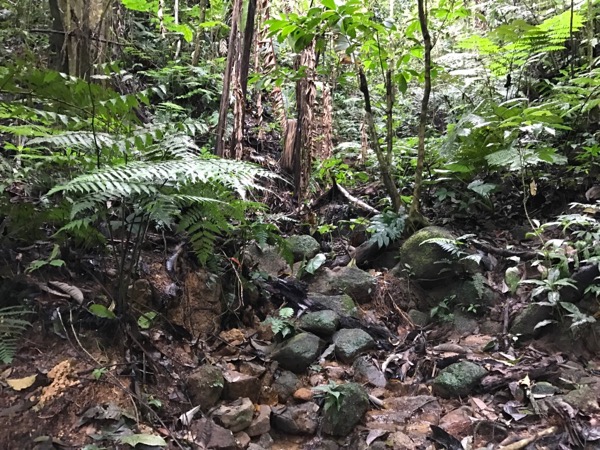
A road called the Jalan Girdle encircles the highest part of Fraser's Hill. Kurt and I hiked along part of this road one night. I also hiked some or all of it several times while I was staying at Stephen's Place, which is located on this very road. I did not see any herps at all during the day, but the hike was pretty in a foggy sort of way, especially during those brief intervals when it wasn't raining.
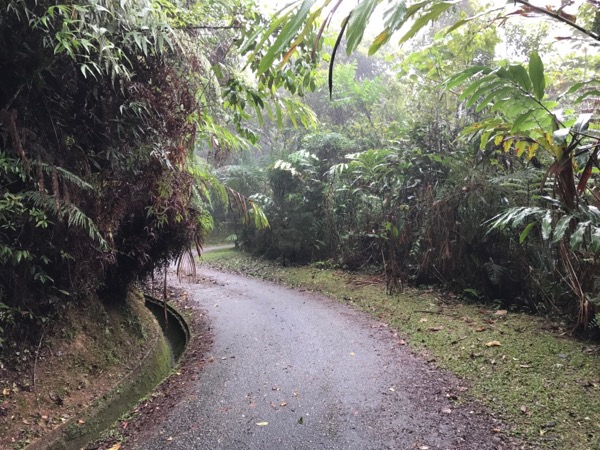
Many years ago a falling tree split one house on Jalan Girdle in two. The left half has been abandoned, but the right half is still occupied by a friendly Canadian guy who gave me a ride to the airport at the end of my stay.
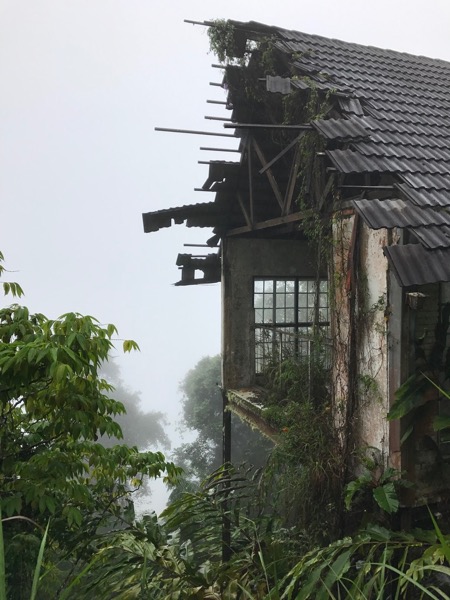
Many interesting invertebrates called Fraser's Hill home. For example, the ants in this aggregation are called Migrating Herdsmen because (A) they have no fixed home, and (B) they live symbiotically with tiny hoppers (slightly visible in this photo) that excrete nutritious honeydew on their behalf. You gotta admit, that's more interesting than your average ant.
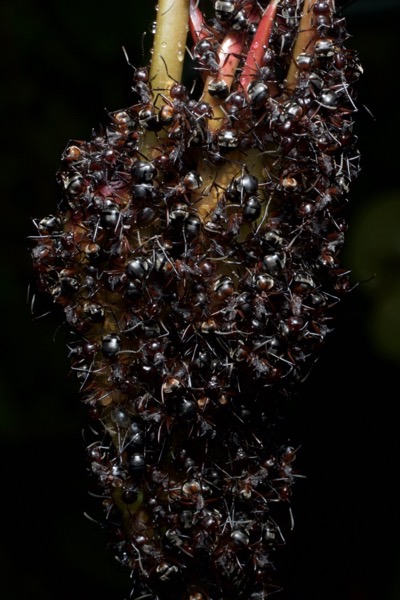
We saw a few more of these lovely moths, the same species we had seen back on my first night of this trip.
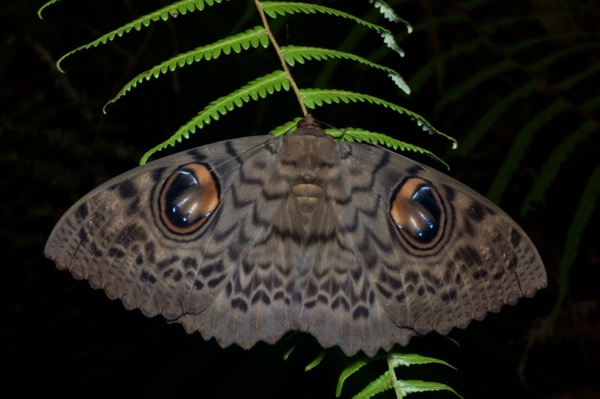
I saw several fine phasmids around Fraser's Hill. Here's a teeny tiny one, presumably a young nymph, doing what stick insects do when they aren't holding perfectly still.
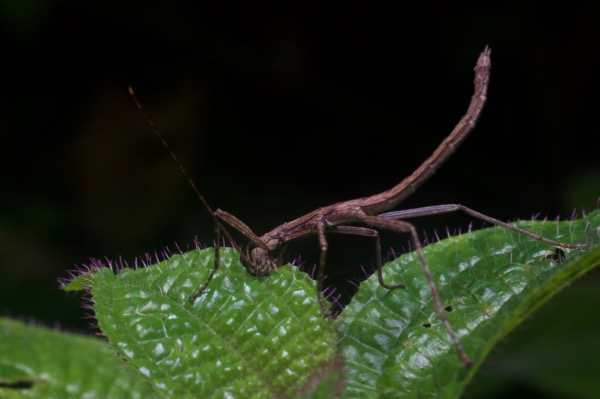
The most noticeable phasmids here were bright green adult female Malayan Jungle Nymphs. I saw at least a few of these each night. (Don't complain to me about "adult Nymphs". I didn't name them.)
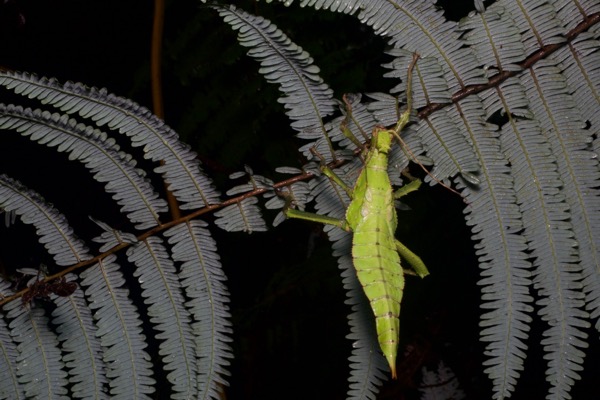
I have been told by a phasmid expert (a phasmologist? a phasmidian?) that this is a male Malayan Jungle Nymph drying after its final molt.
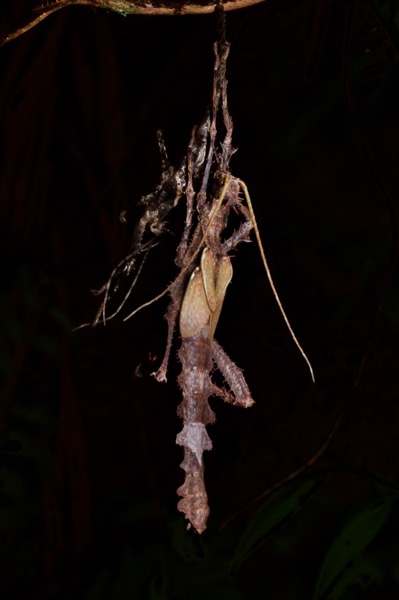
At first glance I thought this was another big female Malayan Jungle Nymph. But looking more closely, I saw that it was covered with far more spines than that species. Depending on whose taxonomy you follow, this adult female is either a Müller's Haaniella or an Errington's Haaniella. I will let those two gentlemen fight it out.
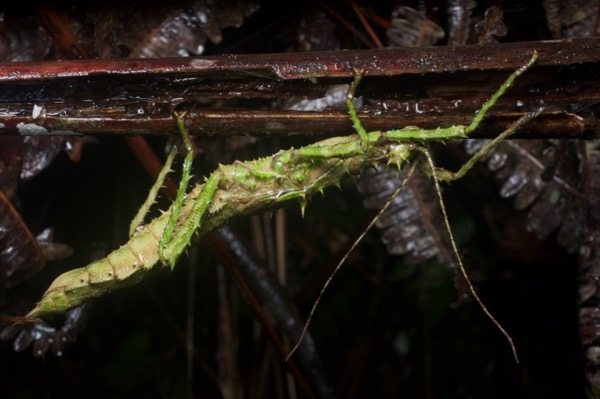
I believe this one is the same species, whatever that is.
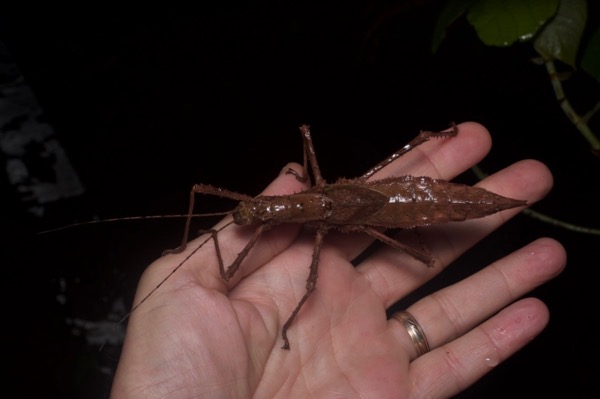
Fraser's Hill has some particularly noteworthy spiders. This is not one of them. However, it is a cool-looking spider.
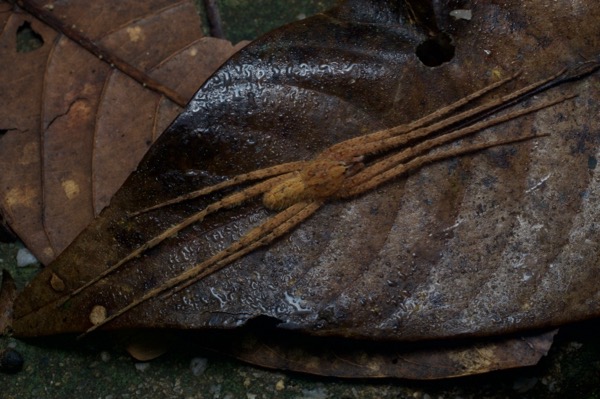
The noteworthy ones can be found in their tunnels on the embankments of some of the road cuts. This species of tarantula is named after Stephen Hogg, a.k.a. the Stephen of Stephen's Place. He carefully observed and documented these spiders for years before they were officially described, and was justly rewarded with the patronym.
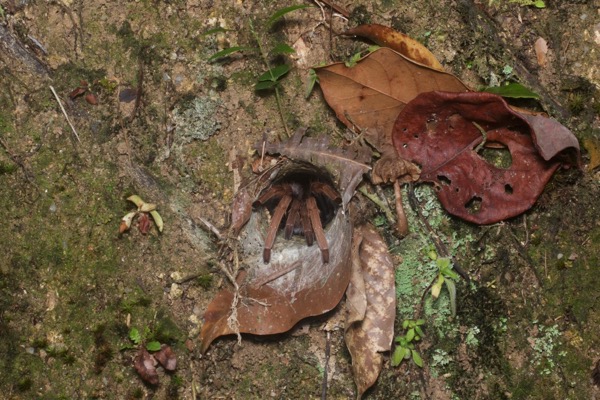
This one was out wandering, not near any tunnel. Stephen told me that it was a recently molted four-year-old male. At this life stage it no longer eats; its only goal is to find a female to mate with before it dies.
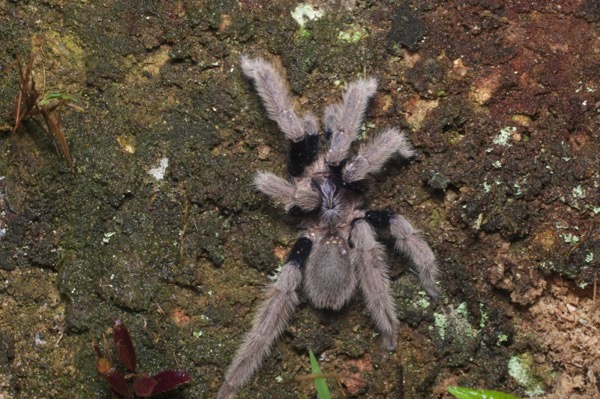
As if one noteworthy species of big tunnel-inhabiting spider were not enough, Fraser's Hill is also home to a large trapdoor spider that hides behind a burrow-obscuring flap of vegetation held to the embankment by a set of radiating threads. When a bug walks past and tickles these threads, the spider feels the vibration, pushes the flap open in a fraction of a second, and leaps out of the tunnel to snatch the hapless passerby.
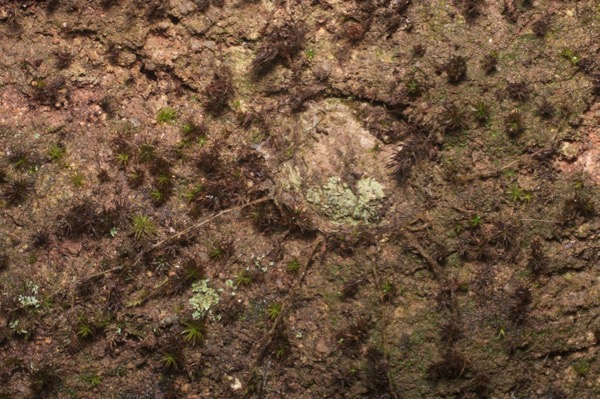
It is possible, with just the right gentle touch, to trick these spiders into leaping out of their tunnels for a quick photo opportunity. Here is a nice fat healthy one. We guided it back to its lair after taking a couple of pictures.
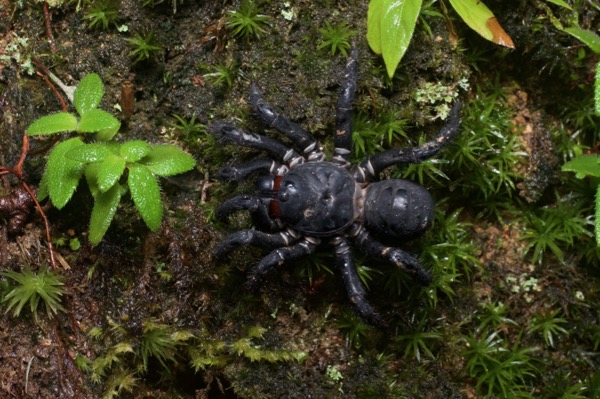
The tarantulas and trapdoor spiders are both officially protected, but unfortunately their numbers have plummeted in recent years due to poaching for the pet trade. The poachers don't bother to trick the spiders out of their tunnels; they just take shovels to the general area, wrecking the habitat completely. I saw fresh evidence of this kind of destruction in multiple places. Stephen has estimated that the spiders are likely to be extirpated from Fraser's Hill within a decade at the rate that they are being taken. Since the microclimate (humidity, temperature, barometric pressure, etc.) required by these spiders is difficult or impossible to recreate in the lowlands, they usually die quickly in captivity. This makes them very rare in captivity, which makes them even more desirable, which accelerates the pace at which they are poached and their habitat is destroyed.
Adult male trapdoor spiders share the mate-seeking behavior of the tarantulas. After their final molt, they leave their burrows and head out in a foodless search for a mate. This might take a long time (especially if the nearby females have been poached), and the male grows skinnier and skinnier as his quest continues. Here is one that we found out on the prowl that we didn't even recognize as the same species, since he was so shrunken. Stephen confirmed the ID later.
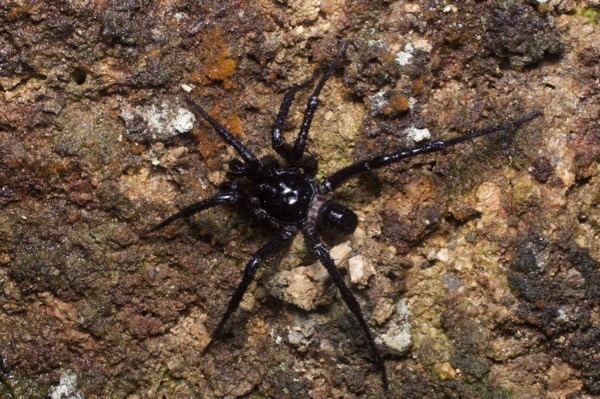
One evening while hiking around the Jalan Girdle I saw something apparently floating in space about head-high. I first thought it was a spider, then perhaps a caterpillar, but it turned out to be a snail. That was a first for me, though Kurt told me he has seen this before.
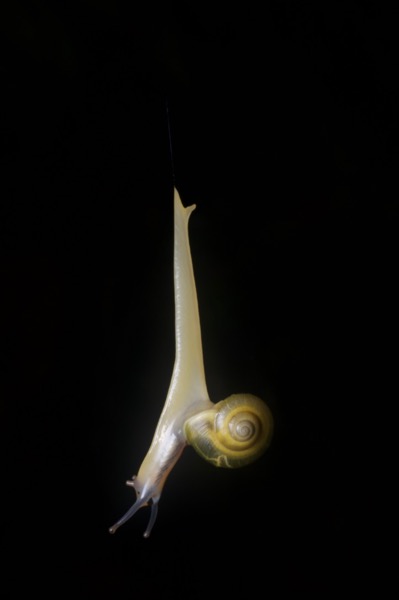
One morning I waited at Stephen's Place until a break in the rain, around 11am. Stephen drove me down to the Jeriau Waterfall area. He joined me in poking around some boards and wooden pallets to see if anyone might be hiding there, before leaving me to walk back up the hill on my own. We found a couple of skinks. This one we managed to spook out of the pile of pallets and under a board that we had placed in a more open area for this reason. It turned out to be the most common skink for this part of the world, the same species I had seen my first night in Malaysia.
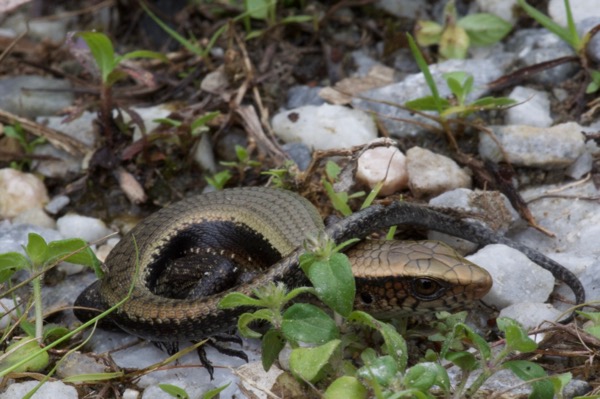
This little baby gecko was hanging out in the same pile of pallets as the skink. I am not extra confident about its ID since it's such a young 'un, but my best guess is that it is an Asian Flat-tailed House Gecko.
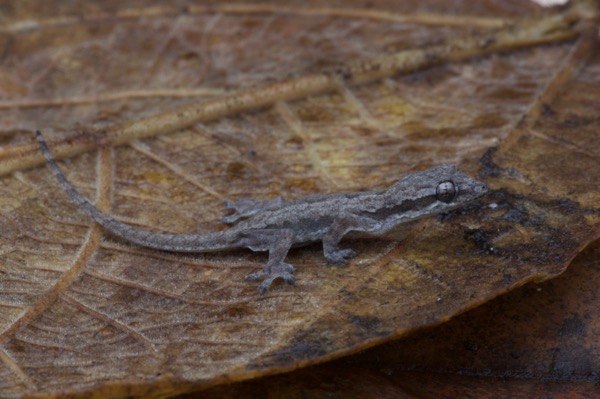
At various elevations on Fraser's Hill I saw various geckos that I had seen earlier on my trip. Down near the Jeriau Waterfall was this Four-striped Bent-toed Gecko.
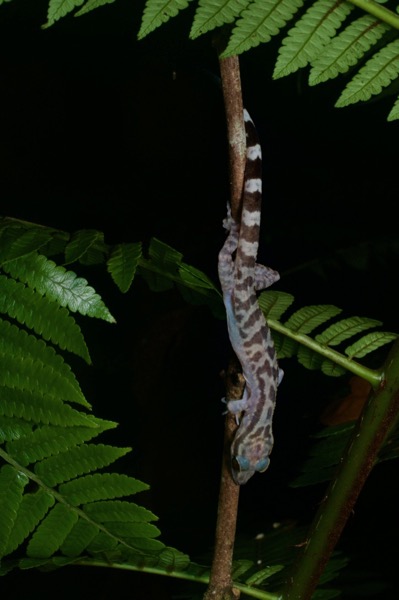
Way up high on the Jalan Girdle I saw a few of these geckos, which belong to the same as-yet-undescribed species as the ones I had seen in our previous highlands location.
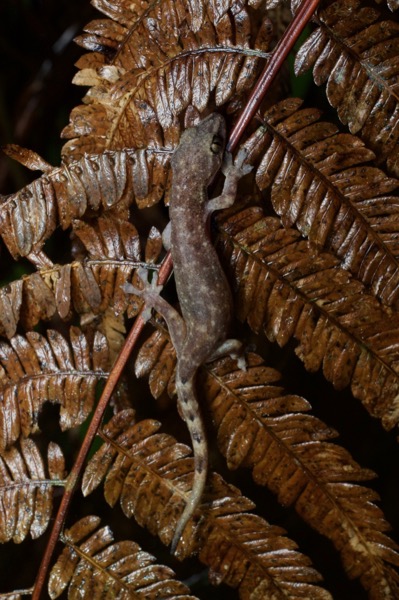
Also up on the Jalan Girdle I finally got a decent photo of a Spotted House Gecko that wasn't a tiny baby. It was only medium-sized though, not a large adult.
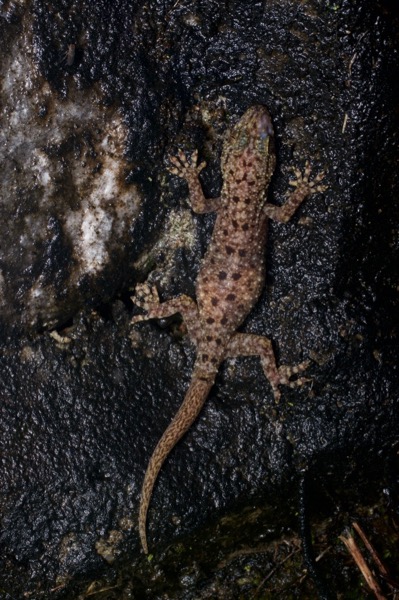
The best-looking and best-named gecko of the area was also a denizen of the highest of the highlands. This gecko might set some sort of record for number of characters in its scientific name. Behold the lovely Cyrtodactylus australotitiwangsaensis!
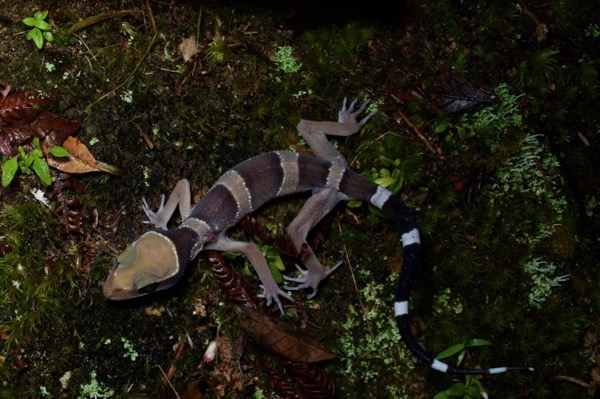
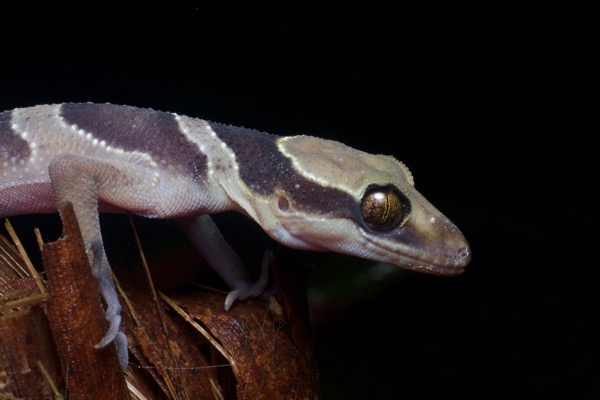
That mouthful of gecko's competition for Best Lizard of Fraser's Hill was sleeping peacefully in a tree when Kurt and I explored the Jeriau Waterfall area at night.
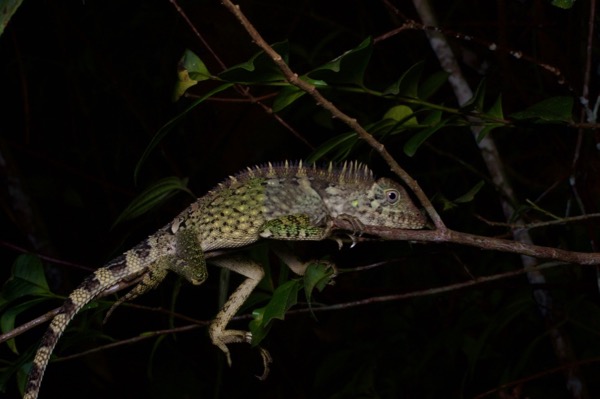
I interrupted its peaceful slumber to convince it to pose in a less slothful position.
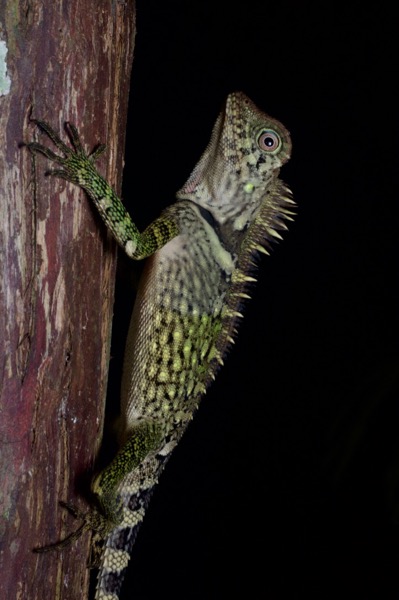
A few minutes after Kurt found that first Gonocephalus, I saw another one that was trying out a different color scheme. It looked particularly grumpy.
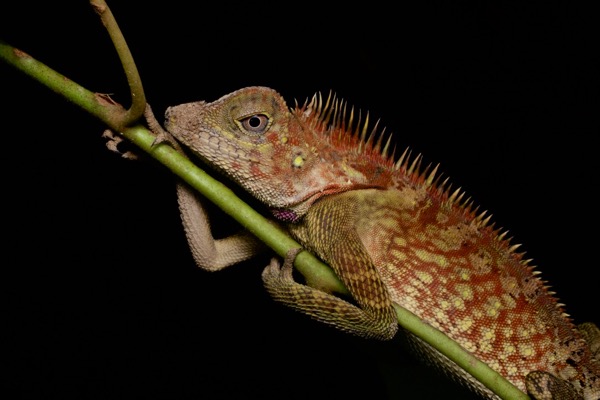
The big forest frogs continue to be tricky for me to tell apart. I'm pretty sure this huge one is a Malesian Frog, based on the sharply-angled fold above its tympanum, and the extra-prominent tubercles above its eyes.
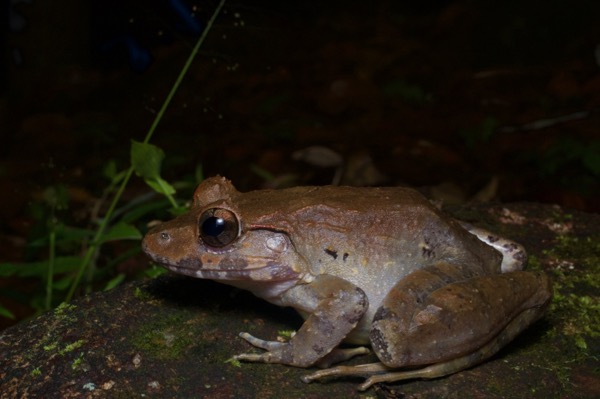
I'm guessing this one is a Giant Malayan Frog due to the gently-curved fold above its tympanum. Those tubercles above its eyes aren't helping with my confidence any, though.
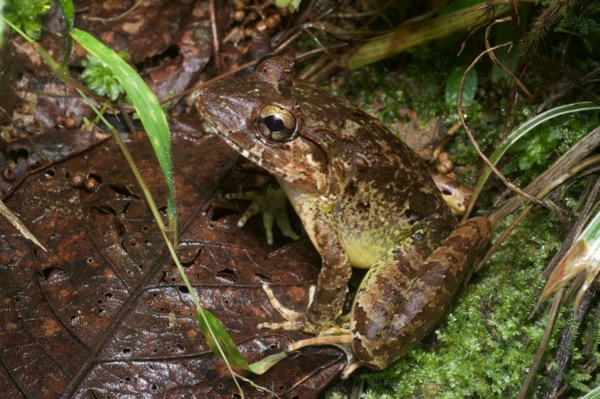
Young Poisonous Rock Frogs look quite similar to adult White-lipped Frogs, green backs, white lips, and all. But the sharp delineation between green back and dark sides marks this one as a Poisonous Rock Frog.
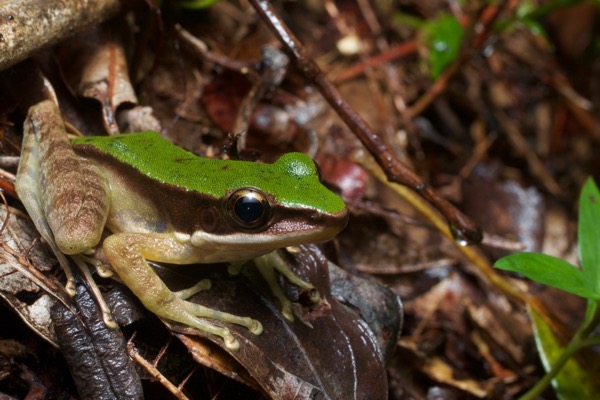
This handsome leaf litter frog is a high-elevation species found in a few mountain ranges in Peninsular Malaysia. "Banjaran" is Malayan for "mountain range".
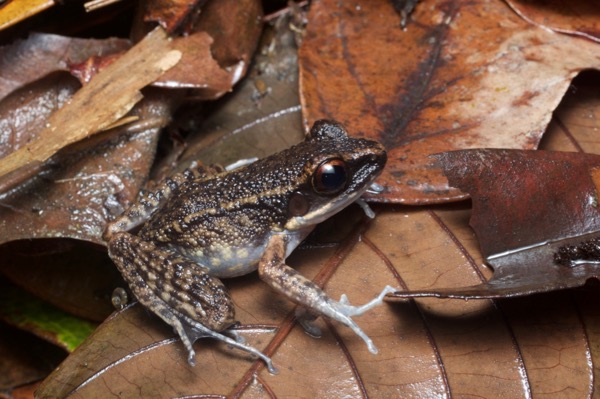
Kurt found my fifth and final species of flying frog high up in the roadside vegetation on the Jalan Girdle. We deployed a long stick to encourage it to come within photography distance. It honored the letter if not the spirit of our request by landing on the unphotogenic road. Afterwards I moved it to a perch in a bush on the side of the road, but it had become disillusioned with its evening activities and dimmed its bright colors to become rather dull-looking. I won't insult your artistic tastes by showing you a photo of this unattractive look.
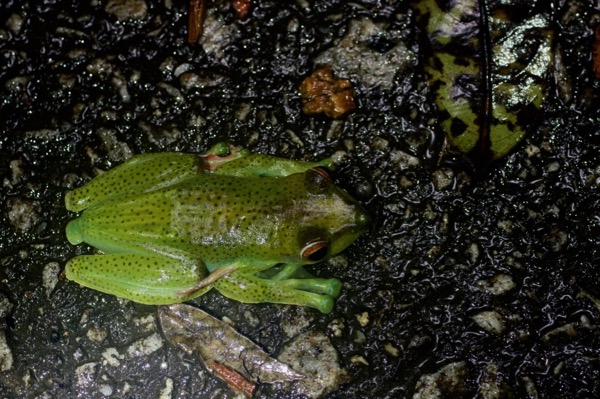
I returned to the same area on two more nights, but never saw another Malayan Flying Frog. I did see a couple more Twin-spotted Flying Frogs though.
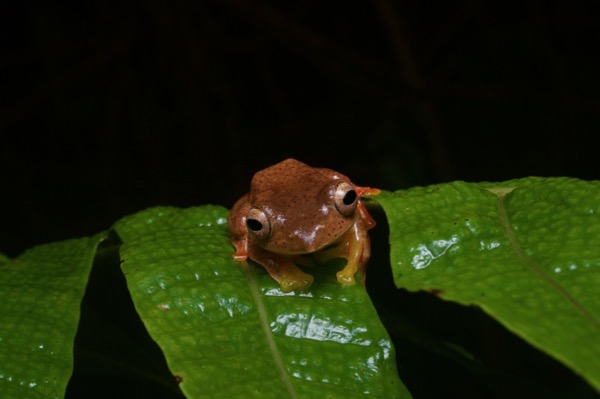
Everyone's favorite Malaysian non-flying frog is the Malaysian Horned Frog, Megophrys nasuta. When Kurt saw the right intensity of eyeshine in the leaf litter, he thought he had found one of those beloved beasts. But a closer look revealed that it was a lesser-known cousin, the Slender-legged Horned Frog, which Kurt calls "the poor man's horned frog".
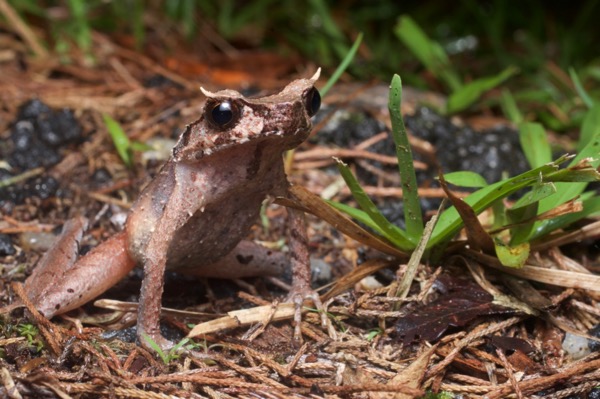
After we found a couple more X. longipes, Kurt saw more promising eyeshine. It's a frog, not a spider, check! It's in the leaf litter, check! It's hard to distinguish the frog shape from the surrounding leaves, check! It's a thicker, more robust frog than X. longipes, check! Is it Megophrys nasuta? No, it's yet another cousin species, the Perak Horned Frog. Still not quite as dramatic as Megophrys nasuta, but pretty darn dramatic nonetheless.
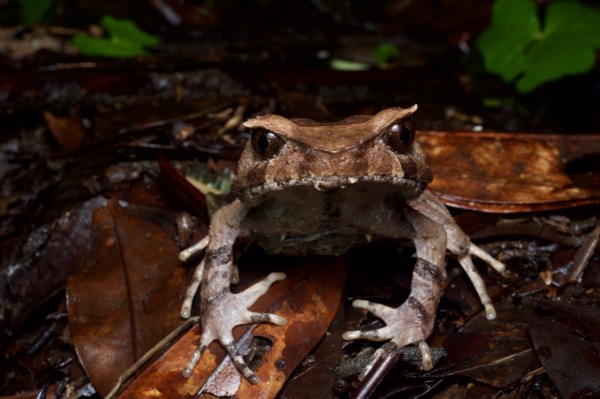
Down by the waterfall I saw a small banded snake poking around on a steep embankment. Not knowing my Malaysian snakes well, I called for Kurt's assistance. He took a moment to decide that it was not a highly venomous banded krait, then captured it for photos in a spot a few feet away, where the snake was less likely to escape. The snake was not particularly thrilled with this temporary displacement, expressing its displeasure by biting Kurt a few times. Good thing it wasn't a highly venomous banded krait.
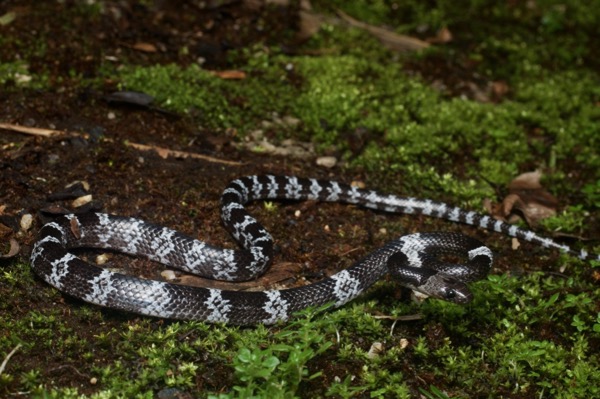
Up near the top of the hill we found a sleeping colubrid about eight feet up that we couldn't identify conclusively from below. We got it down to realize that it was a Dendrelaphis species that we had seen earlier on this trip, on the first night. The snake was extra wiggly and we grew tired before it did, so I just got a couple of voucher shots and we let it on its way.
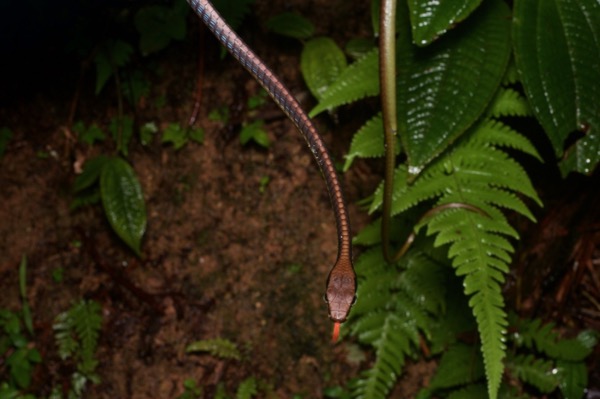
Kurt was quite surprised when we road-cruised an arboreal snake slowly meandering across the pavement.
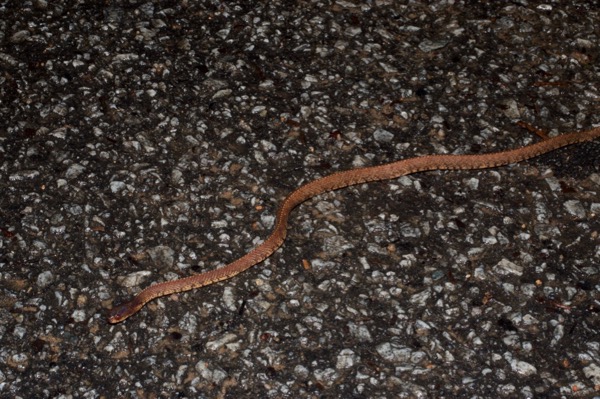
This little non-venomous slug-eating snake thought it could scare us with its very best viper imitation, which was a very poor viper imitation. When we blocked its forward progress with a hand, the snake made a decent enough S-curve, but then lunged extremely slowly about two inches to the left of the progress-impeding hand. Still, those red eyes are pretty scary, as long as you ignore the cute grin they are poised above.
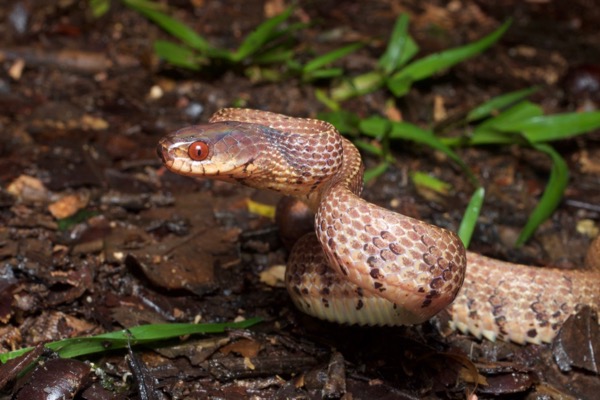
The one snake we could actually call common on Fraser's Hill was the pretty green Siamese Peninsula Pit Viper. I saw nine of these while I was there, some with Kurt and some by myself. Though they match the vegetation that they typically occupy very well in color, they reflect quite differently, so they're relatively easy to spot at night with a flashlight.
The first one we saw was this male. Males have a white-and-red stripe separating the belly from the sides. Kurt spotted this guy eight or ten feet up the embankment at the side of the road we hiked along.
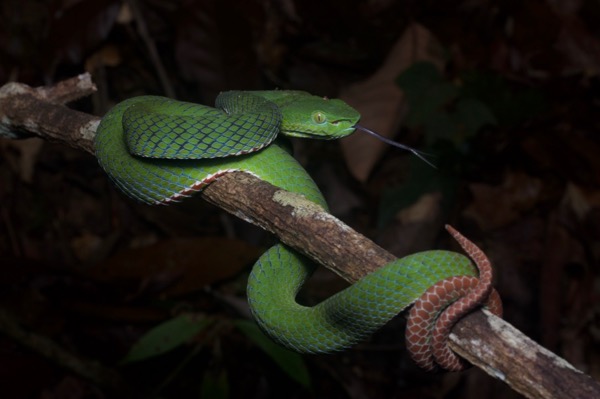
When he climbed up the embankment to fetch the viper for photos, Kurt heard a rustle right next to him and glanced down to discover a second viper, this one a female. The two snakes were maybe six feet from each other. Perhaps we interrupted the early stages of a romantic first date? She looks like she wants to kiss something, don't you think?
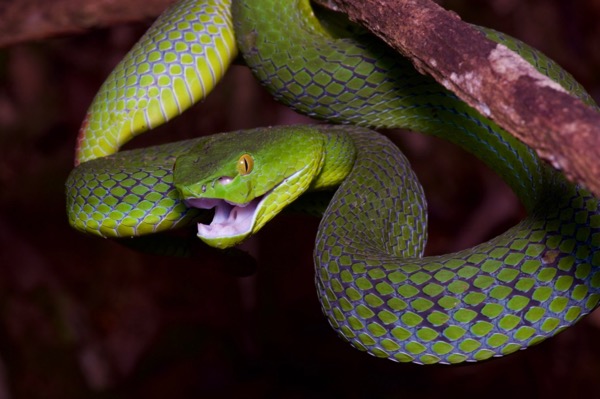
I've got a bunch of pictures of this species, but to avoid excessive repetition I'll just include one more, this one in situ.
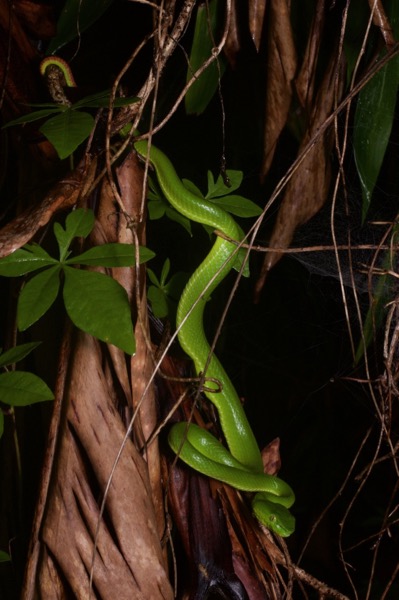
Despite the near complete lack of sunshine, I saw a fantastic assortment of herps in my nine days and nights in Peninsular Malaysia. This was mostly due to Kurt, who knows where to go to look for them and is great at finding them once you get there. He also gave me many tips to improve my photography. If you are interested in the herps of this part of the world, and you should be, you can't go wrong by signing up for a guided tour with him.
Next: Kubah